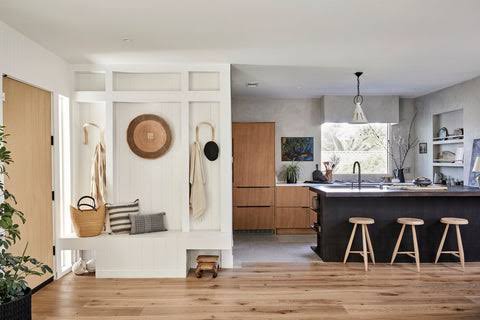Japandi Style: The Blend of Japanese Minimalism and Scandinavian Simplicity
 Japandi style, a fusion of Japanese and Scandinavian design principles, has been gaining popularity in the world of interior design. This unique aesthetic combines the best of both worlds: the sleek, minimalistic lines of Scandinavian design and the warmth and tranquility of Japanese aesthetics. The result is a harmonious blend that creates serene and functional spaces with a focus on simplicity and natural beauty. Here’s a closer look at what makes Japandi style so appealing and how to incorporate it into your home.
Japandi style, a fusion of Japanese and Scandinavian design principles, has been gaining popularity in the world of interior design. This unique aesthetic combines the best of both worlds: the sleek, minimalistic lines of Scandinavian design and the warmth and tranquility of Japanese aesthetics. The result is a harmonious blend that creates serene and functional spaces with a focus on simplicity and natural beauty. Here’s a closer look at what makes Japandi style so appealing and how to incorporate it into your home.
1. The Core Principles of Japandi Style
Japandi style is rooted in the philosophy of minimalism, which emphasizes simplicity, functionality, and the elimination of excess. It draws from:
- Japanese Aesthetics: The Japanese influence in Japandi style comes from the concept of “wabi-sabi,” which finds beauty in imperfection and embraces natural materials and craftsmanship. Japanese design often focuses on creating a sense of calm and balance, using a neutral color palette and organic shapes.
- Scandinavian Design: Scandinavian design, known for its functionality, clean lines, and light color palettes, complements the Japanese aesthetic with its emphasis on coziness and comfort, or “hygge.” This design philosophy prioritizes comfort, light, and space, creating a warm and inviting atmosphere.

2. Neutral and Muted Color Palette
The Japandi color palette is typically subdued, featuring neutral tones such as beige, white, soft gray, and muted earth colors like sage green or terracotta. These colors help create a calm and soothing environment, which is key to both Japanese and Scandinavian styles. The occasional use of darker tones, such as deep blue or charcoal, can add depth and contrast to the space without overwhelming the senses.
3. Natural Materials and Textures
Japandi style heavily emphasizes natural materials, which reflect a respect for nature and craftsmanship. Common materials include:
- Wood: Light woods like oak, ash, and beech are often used for Scandinavian-inspired furniture, while darker woods like walnut and teak bring in the Japanese influence. Both types are celebrated for their natural grain and texture.
- Bamboo and Rattan: These materials add an organic element and are often used for furniture or decorative accessories, enhancing the natural feel of the space.
- Stone and Ceramics: These are used for both decorative and functional pieces, such as vases, bowls, or tableware, adding a tactile quality to the design.
- Textiles: Soft, natural fabrics like linen, cotton, and wool are used in Japandi interiors to add warmth and comfort while maintaining simplicity.

4. Minimalist Furniture and Clean Lines
Furniture in Japandi design is characterized by simple, clean lines and a focus on functionality. Pieces are often low to the ground, reflecting a Japanese influence, and feature sleek, uncomplicated silhouettes typical of Scandinavian design. The aim is to create a space that feels open and uncluttered, allowing for free movement and a sense of calm.
5. Functional Decor with Purpose
In Japandi interiors, every item has a purpose and place. Decor is kept to a minimum, and any decorative items are carefully chosen for their simplicity, beauty, and functionality. This might include handcrafted pottery, a carefully placed houseplant, or a few well-selected books. The idea is to avoid clutter and maintain a sense of order and tranquility.
6. Focus on Light and Space
Both Japanese and Scandinavian styles prioritize natural light and space. Large windows are often left unadorned or covered with light, airy curtains to allow maximum daylight to flood the room. The layout of the furniture is thoughtfully planned to create a sense of spaciousness and flow, with each piece serving a specific function without overpowering the room.
7. Bringing Nature Indoors
Japandi design frequently incorporates elements of nature to create a serene, peaceful environment. This can be achieved through the use of houseplants, which add a touch of greenery and life to the space. In addition, natural elements like stones, wood, and ceramics are used to create a connection with the outdoors, enhancing the sense of calm and well-being.
8. Embracing Imperfection
A key aspect of Japandi style is embracing the concept of “wabi-sabi,” which finds beauty in the imperfect and incomplete. This could mean choosing handmade ceramics with slight variations or furniture that shows the natural grain and knots of the wood. The idea is to appreciate the uniqueness and character of each piece, rather than seeking perfection.
How to Incorporate Japandi Style into Your Home
If you’re looking to bring Japandi style into your home, start by decluttering your space and focusing on a neutral color palette with natural materials. Choose functional, minimalist furniture with clean lines, and incorporate a few carefully selected decorative items that reflect simplicity and craftsmanship. Finally, maximize natural light and introduce elements of nature, such as plants or natural textures, to create a serene and balanced environment.
Japandi style offers a fresh and modern approach to interior design that emphasizes simplicity, functionality, and a deep appreciation for natural materials. By combining the best elements of Japanese and Scandinavian aesthetics, Japandi creates spaces that are not only beautiful but also calming and functional. Whether you’re looking to revamp your entire home or just add a few touches, Japandi style provides a versatile and timeless framework for creating a peaceful living environment.


